A rueful response.
It requires an unequivocal catastrophe to unite left and right in either Britain or America for common cause these days. Not even the heartrending tragedy in Ukraine has done that, at least not in the United States. Tate Britain therefore has given the transatlantic polities a great gift with “Hogarth and Europe.” Even Ireland in the form of the Irish Times has weighed in on the side of the angels.
As a trenchant Jackie Wullschläger observes in the Weekend FT, the commentary accompanying the show amounts to “an instruction not to enjoy the paintings.” Rachel Cooke from The Observer found that “the longer I stayed, the more the feeling grew in me that I was not really allowed to enjoy what I was seeing, and that if I did, I was a bad or insensitive person…. In something of a massive own goal for the gallery, I’d been made anxious and weary.” (Cooke) As Michael Prodger concludes in The New Statesman, the Tate interpretation “starts out as distracting but quickly becomes insufferable.” (Prodger)
Everything English is awful.
The exhibition is a dreary example of the national self-loathing that infects a broad segment of English academia. According to the text that accompanies the paintings, “Hogarth’s freedom of opinion, his critical freedom, the freedom of his characters… might seem to be something always to defend.” “But,” Wullschläger warns, “no.” Instead Tate Britain goes on serially to denigrate everything Enlightenment, European or elite, and especially British, an obsession that characterizes current conventional wisdom. “Enlightenment ideas” for example are hideously flawed because they
“were mainly produced by and benefitted white men from the middle and upper classes. The concept of European superiority deepened, entrenching ideas about nation, personal identity and racial difference, manifested in the horrors of transatlantic slavery.” (Wullschläger)
Leaving on one side the inconvenient fact that Enlightenment thought was profoundly and universally antislavery, although to its twenty first century critics the Enlightened aspiration to universal values itself constitutes another crime, the pictures themselves depict something different. Hogarth was so radical, and his savage satire of high society so humane, that his work takes “a tightrope walk between critique and empathy.” (Wullschläger)
The Tate curators either have missed or ignored Hogarth’s double dance on the wire. Take for example the painting evocatively called “O the Roast Beef of Old England” or, prosaically, “The Gate of Calais.” A satire of high comic order, “Hogarth and Europe” dismisses it as a derivative exercise in crude, ugly xenophobia or “compendium of xenophobic stereotypes.” Sometimes, however, as the saying goes, a paranoid is being stalked.
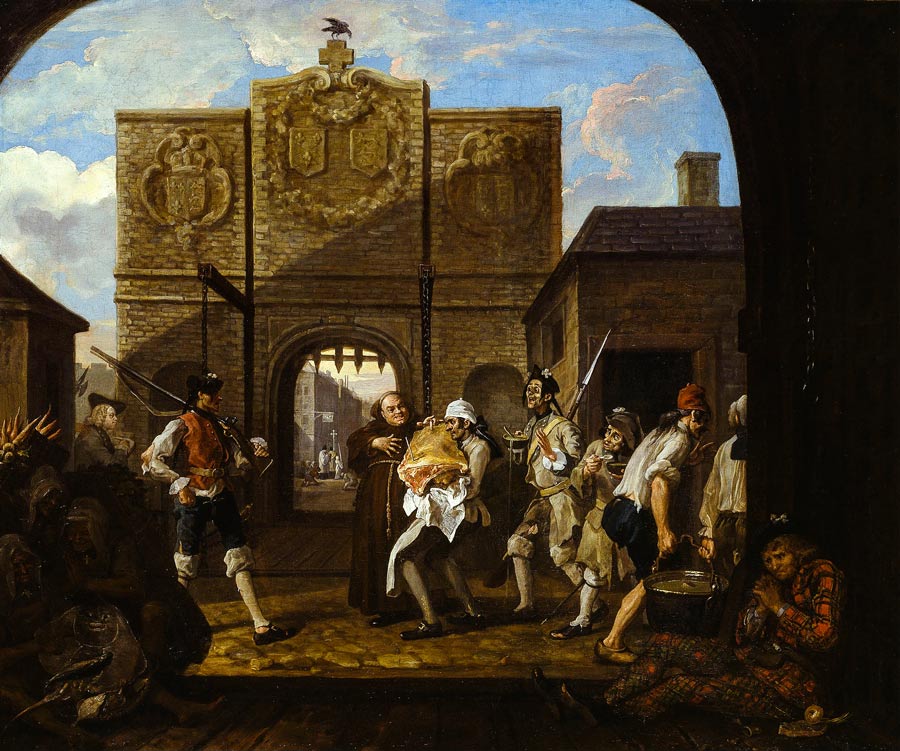
An empiricist original.
Hogarth, an artistic original, had just travelled to France before executing the painting, where he was arrested on a trumped charge of espionage while sketching that gate he depicted. He was genuine enough in his dismay at the poverty and (actual) oppression he found around him, and likely was not thrilled with the arrest either. (Baldwin) Nor however did he fear or hate the French as the Tate inadvertently demonstrates in noting his friendship with French painters, alleged evidence only of his derivative work. He did sympathize with the circumstances plaguing other French people:
“The scene draws attention to the ‘fussy’ nature of French cuisine, which Hogarth, like many visiting Englishmen, found to be most ironic at a time when shortages of food, and particularly meat, were common for the majority of the French populace.” (Sanders)
The brontosaurus sized English sirloin a burly cook carries appear as ridiculous as anything French in the picture. With Hogarth all pretense is fair enough game for a gut punch.
The side of beef itself may be too much for the Tate. Sliced tofu swimming in a seaweed bath instead of meat would satisfy its self-righteous sensitivity but that would sacrifice eighteenth century sensibilities to the agenda of the oppressionists. Who knows; the Tate analytical tools, double entendre intended, may interpret that ox carcass as symbolizing murdered victims of imperial cruelty.
Supportive enough subversion.
Prig that he was, George II refused Hogarth’s gift of “The March of the Guards to Finchley” because he believed it made a mockery of the British army. And so it did… and ultimately did not.
Wullschläger is brilliant on the layered social commentary of ‘the March.’ Hogarth depicts not only a “raucous tactility” of the the eighteenth century but also its “democratizing and economic forces that favoured bourgeois spectacle, blurring boundaries between the theatrical and the real.” Hogarth travels further down the social scale too, to celebrate “a middle and working class previously unacknowledged in British art,” in ‘the March’ and a raft of other paintings.
They only think they actually matter.
His “gorgeously individualized” group portrait of six servants (all of them white; this was eighteenth century London, an overwhelmingly white metropolis) might appear to the uninitiated as the humane, respectful and even affectionate depictions Wullschläger describes. According to Tate Britain that generous reading misses the invidious point: “Such apparently informal studies seem to suggest a new spirit of individualism, but inequities of race and social status persisted.”
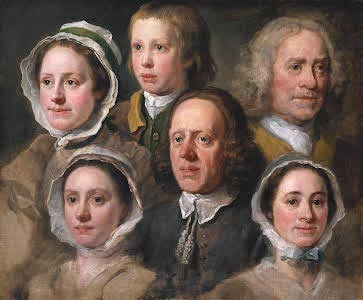
Whether or not those inequities existed more generally they are absent from the picture, which after all should have been the focus of the curator, not a preoccupation with the shallow sociological vogue for universal (irony alert) oppression and victimhood in all things.
By eerie coincidence the portraits do considerably more than “suggest a new spirit of individualism.” They celebrate that spirit and those individuals, and individual dignity. Individuality may also present a problem to the pseudo-collectivist preachers of oppression. Whether or not that is the case, in their telling the otherwise intelligent appearing servants probably have been bought off by their wages and blinded by contentment to the point they do not realize they are oppressed.
Confident comedic chaos.
The jostling society that Hogarth records is absent from the commentary with which Tate Britain has saddled this dazzling work. His was, to take a term from Ruth Scurr and Penelope Corfield, an age of optimism.
In ‘The March,’ Wullschläger again, she is irresistible here, soldiers at the foreground of the painting mix with townspeople, “drinking, pissing, vomiting, stealing, brawling, flirting,” an “arabesque of heads--glinting helmets, old men’s wigs, baby’s bonnets, lopsided bicorns [tricorns would await the second half of the century], pugilists’ bald pates.”
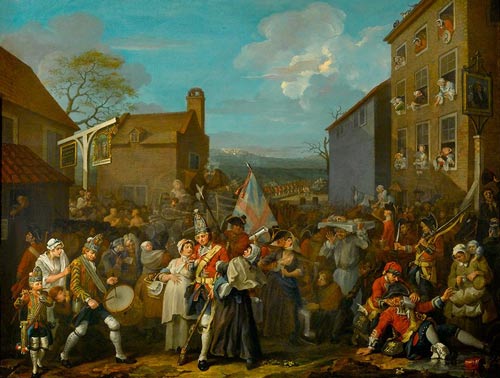
All of life is out and about in Finchley and on the road to town, and all of it exudes a crazy confidence: “Hogarth’s boisterous Britain looks chaotic but knows where it is headed. Orderly troops march in the distance.” Even in the riotous town center, where a singer slaps away a Jacobite broadsheet and a “Union flag flutters,” a fractious nation celebrates itself. With an insight lost to Tate Britain, Hogarth understood that it was an astonishing time to be British. (Wullschläger)
After all, the inimitable Brigid Brophy, gifted as she was with “sheer artistic insolence,” understood that “the two most interesting subjects in the universe are sex and the eighteenth century,” intimately and irrevocably intertwined as the topics were and remain. Hogarth understood that too. (Scholes; Scurr; Cheetham, “morphogenic erotics”)
Political hijacking.
Historians and art historians of Whiggish bent always have considered Hogarth both uniquely English and profoundly patriotic. “The progressive left,” according to Kathryn Hughes, also “has always had much invested in Hogarth as a class warrior and fearless critic of developing capitalism.” Those perspectives, according to Tate Britain, give the painter untoward credit; “it would be wrong,” argues one of its curators, “to call him a revolutionary.” And, Hughes goes on, “to suggest Hogarth hated capitalism would be as misleading as insisting on him as a proto-Brexiteer.” (Hughes)
All of that is anachronistic; none of it helpful in understanding the man or his work. Progressive politics and the ongoing debate over capitalism that obsesses oppressionists have nothing to do with Hogarth, his art or their era.
The attempt of Tate Britain to recast Hogarth and his Continental contemporaries more broadly in terms of Brexit (loathsome word and fact that it itself represents) does nothing to advance any understanding of his work, while the breathless effort the Tate claims is groundbreaking to recast Hogarth himself as a mere imitator of those contemporaries is disingenuous.
Nothing new.
The observation that Hogarth had viewed continental paintings is neither new nor proof of his lack of originality, as the paintings presented to support the point themselves demonstrate. In an essay from back in 1947 the noted art historian Frederick Antal identified as influences Bruegel, Callot, Annibali Carracci, Cochin, Coypal, Gillot, Gravelot, Raphael, Rubens, Steen, Vaga and others while admitting:
“What has been attempted in this article is but a beginning. Even Hogarth’s borrowings themselves require to be given a far wider background…. We should take into account not only his few direct borrowings but, in a historical sense, all his oremises and parallels, his close stylistic contacts with all the variant trends of European art whether he knew them or not (and his acquaintanceship was, in fact, even broader than we have suggested here).”
The key word from the passage for the present purpose is “few.” “Taking Hogarth’s art as a whole,” Antal goes on to explain, “his borrowings are those of an extremely original and extremely realist artist…. ” (Antal 47)
A theory of contemporary common sense.
In a discussion of Hogarth’s own Analysis of Beauty, nothing less than a manifesto of art theory, Mark Cheetham points out that “Hogarth deplores the blind adherence to European norms” and subverts classical models with a decidedly empiricist, English, modern and original vision:
The Englishness of Hogarth’s art theory lies also in his practical contemporaneity, his advice to assess and render objects according to the eye and common sense instead of European hierarchies.” (Cheetham 36)
“Hogarth,” Cheetham continues, “sees the world as a network of kinetic lines, as a great shell with rays extending from objects to us and reciprocally from our sense to objects.” (Cheetham 37)
Hogarth displays a distaste for the temperamental gluttony that characterized precapitalist elites no less than the great robberbarons whose conspicuous consumption disgusted Veblen.
No women please, we are feminists.
Hughes takes the obligatory swing at patriarchy in contending that before Hogarth “it was only princesses and empresses” among the multitudes of women “who were painted, their bodies used as fleshy Christmas trees on which to dangle the symbols of their husbands’ wealth.”
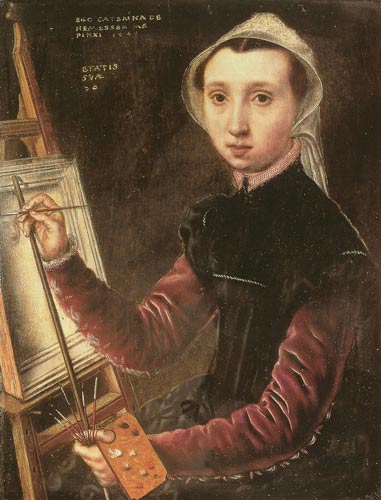
The apparently apt observation is so ahistorical and misleading, misleading because the argument contains a seductive kernel of truth, that the claim requires extensive explication. Centuries before Hogarth, during 1548, Catharina Hemessen painted the first signed self-portrait by any artist, in Antwerp where women held an outsized place in the commercial life of the city. The painter, neither princess nor empress or baubleframe, looks directly at her audience, brush and palette in hand, painting the portrait itself. She wears an elegant but practical velvet tunic over a fitted blouse and casts a frank gaze at her viewer. (Uglow)
All about Africa…
In its fevered attempt to mount the bandwagon of racial reckoning, the Tate takes a few leaps of fatuous fancy. “The Tate curators,” Hughes reports with approval, “suggest that Hogarth may well have been inspired by images of in Jean-Antoine Watteau’s sketchbook, in which the French artist, normally associated with whimsical fêtes galantes, practices drawing people of African descent.” (Hughes) The trifling problem with the curators’ speculation; nothing else let alone the appearance of Hogarth’s servants or his depiction of them suggests any such thing. Notwithstanding the contortions of the oppressionists, it is just not true that all historical roads lead inexorably to Africa.
An imagined invasion, or, let’s generalize about men.
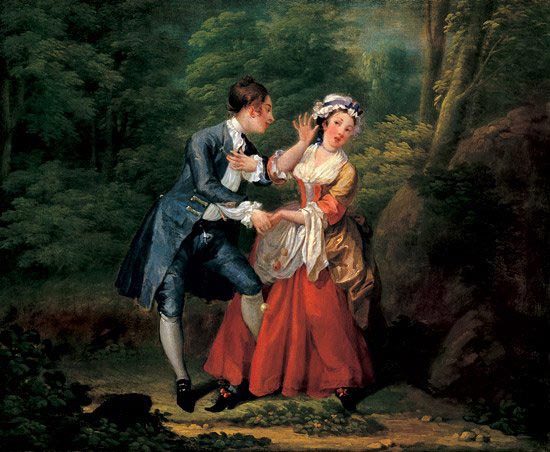
Another species of oppression, rape in the form of “Before and After” from the Fitzwilliam Museum at Cambridge, is different manifestation of the fevered imagination infecting the Tate. The slightest glance at the twinned paintings reveals that they depict something different, consensual, a mutual desire and then satisfaction. As Cooke observes, the Tate interpretation “wilfully ignores both their tone, which is warm and slightly comical, and the fact that in the second painting, the dog is no longer protectively barking (it appears to be asleep),” an allegory of postconjugal contentment. (Cooke)
Let us leave it there.
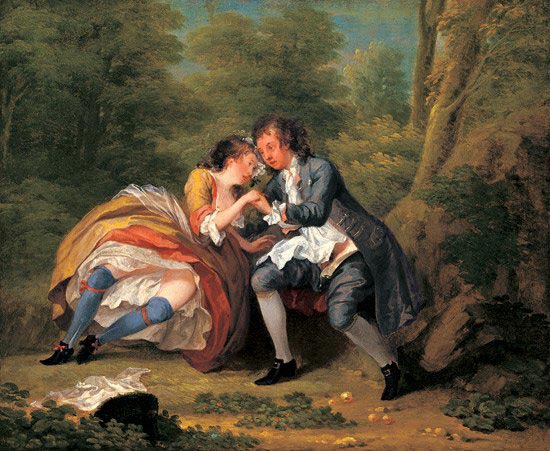
Sources:
Anon., “O the Roast Beef of Old England (‘The Gate of Calais’),” Tate Britain display caption, https://www.tate.org.uk/art/artworks/hogarth-mosley-o-the-roast-beef-of-old-england-the-gate-of-calais-t03918 (August 2004) (accessed 16 February 2022)
F. Antal, “Hogarth and His Borrowings,” The Art Bulletinvol. 29 no. 1 (March 1947) 36-48
Olive Baldwin & Thelma Wilson, “250 Years of Roast Beef,” The Musical Times Vol. 126 No. 1706 (April 1985)
Mark Cheetham, Artwriting, Nation and Cosmopolitanism in Britain: The Englishness of English Art Theory Since the Eighteenth Century (London 2012)
Rachel Cooke, “Hogarth and Europe review-razzle and dazzle but not much fun,” The Observer (7 November 2021) (accessed 19 February 2022)
Martin Gayford, “Ignore the wall text and focus on the paintings: Tate Britain’s Hogarth and Europe reviewed,” The Spectator (4 December 2021)
Kathryn Hughes, “Adieu gin, au revoir roast beef! How Hogarth became a proud European,” The Guardian (2 November 2021)
Michael Prodger, “Hogarth and the Continent,” The New Statesman (3 November 2021)
Sanders of Oxford, “The Gate of Calais, or The roast Beef of Old England,” https://sandersofoxford.com/shop/product/the-gate-of-calais-or-the-roast-beef-of-old-england/ (.d.) (accessed 16 February 2022)
Ruth Scurr, “Age of Optimism,” Weekend FT (5-6 February 2022)
Jenny Uglow, “Europe’s Great Emporium,” The New York Review of Books (24 February 2022)
Jackie Wullschläger, “A brake on Hogarth’s progress,” Weekend FT (6-7 November 2021)

